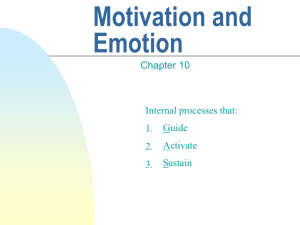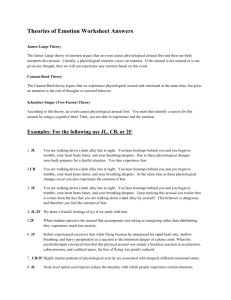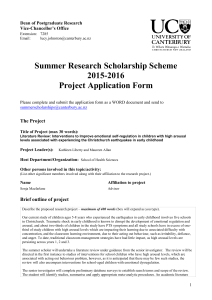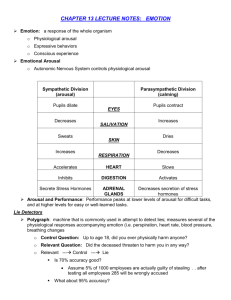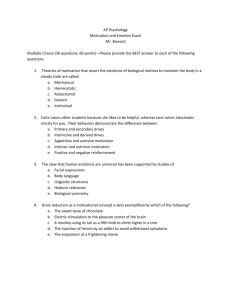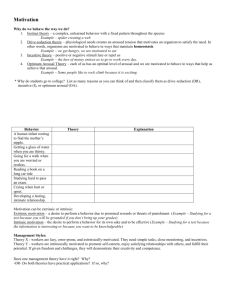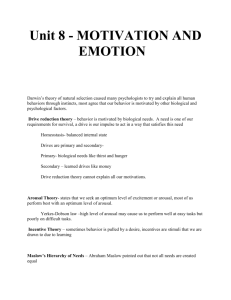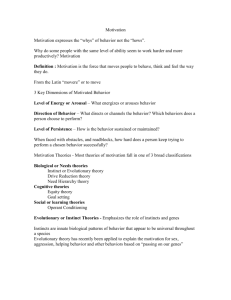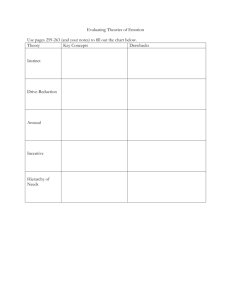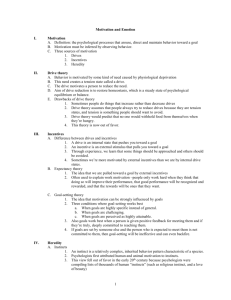ch. 12+13 vocab - Manhasset Public Schools
advertisement
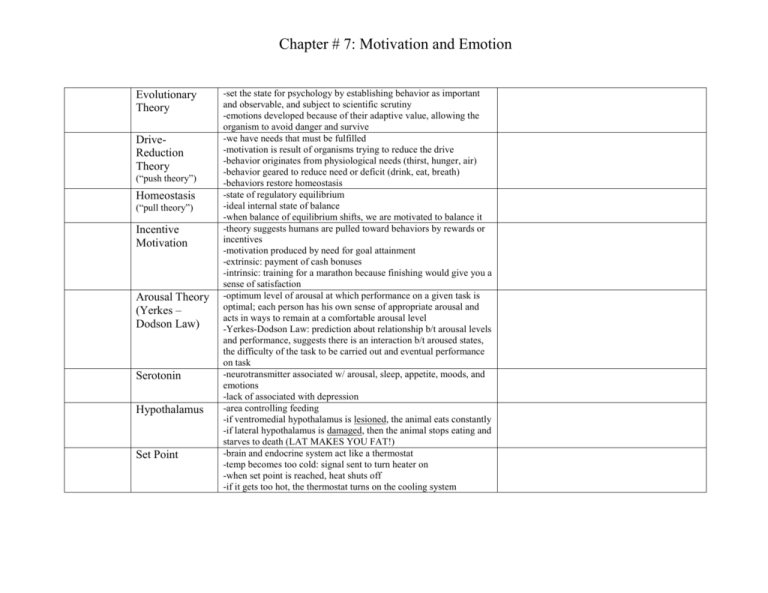
Chapter # 7: Motivation and Emotion Evolutionary Theory DriveReduction Theory (“push theory”) Homeostasis (“pull theory”) Incentive Motivation Arousal Theory (Yerkes – Dodson Law) Serotonin Hypothalamus Set Point -set the state for psychology by establishing behavior as important and observable, and subject to scientific scrutiny -emotions developed because of their adaptive value, allowing the organism to avoid danger and survive -we have needs that must be fulfilled -motivation is result of organisms trying to reduce the drive -behavior originates from physiological needs (thirst, hunger, air) -behavior geared to reduce need or deficit (drink, eat, breath) -behaviors restore homeostasis -state of regulatory equilibrium -ideal internal state of balance -when balance of equilibrium shifts, we are motivated to balance it -theory suggests humans are pulled toward behaviors by rewards or incentives -motivation produced by need for goal attainment -extrinsic: payment of cash bonuses -intrinsic: training for a marathon because finishing would give you a sense of satisfaction -optimum level of arousal at which performance on a given task is optimal; each person has his own sense of appropriate arousal and acts in ways to remain at a comfortable arousal level -Yerkes-Dodson Law: prediction about relationship b/t arousal levels and performance, suggests there is an interaction b/t aroused states, the difficulty of the task to be carried out and eventual performance on task -neurotransmitter associated w/ arousal, sleep, appetite, moods, and emotions -lack of associated with depression -area controlling feeding -if ventromedial hypothalamus is lesioned, the animal eats constantly -if lateral hypothalamus is damaged, then the animal stops eating and starves to death (LAT MAKES YOU FAT!) -brain and endocrine system act like a thermostat -temp becomes too cold: signal sent to turn heater on -when set point is reached, heat shuts off -if it gets too hot, the thermostat turns on the cooling system Chapter # 7: Motivation and Emotion Psychological factors: culture, externals vs. internals Eating disorders: anorexia nervosa and bulimia nervosa sexual response cycle (Masters & Johnson) sexual orientation (psychological and biological factors) Intrinsic vs. Extrinsic Motivation Culturally Universal Expressions of Emotions Culture: -TV commercials -cultural “ideals” of beauty External: -food is readily available -school bell rings signaling it is time for lunch Internal: -hypothalamus -anorexia nervosa: eating disorder characterized by a weight of less than 85% of normal, abnormally restrictive food consumption, and an unrealistic body image -bulimia nervosa: eating disorder characterized by a pattern of eating binges involving intake of thousands of calories, following by purging by either vomiting or using laxative -excitement: sexual arousal -plateau: increased breathing rate, muscle tension, <3 rate and BP -orgasm: ejaculation in males and pleasurable sensations induced by rhythmic muscle contractions in both sexes -resolution: blood leaves the genitals, sexual arousal lessens -refractory period: in most males, another erection or orgasm is not achieved, women are capable of multiple orgasms -one’s degree of emotional and erotic attraction to members of the same gender, opposite gender, or both genders -heterosexual, homosexual, bisexual - 30-70% genetic: if one identical twin is homosexual/bisexual, there is a 50% change the other twin is, too -heredity shapes areas of brain that orchestrate sexual behavior -sexual orientation influenced by gene found on X chromosome -nature and learning -intrinsic: factors originating from within ourselves -extrinsic: factors coming from the outside world -Paul Elkman found that individuals in all cultures tend to recognize and express the major basic emotions (fear, happiness, surprise, etc.) in the same way in terms of facial expression -some kinds of emotional response are inborn in humans (intrinsic) ex: feelings of accomplishment (extrinsic) ex: money Chapter # 7: Motivation and Emotion Catharsis -J-L: J before L, behavior b4 emotion James-Lange Cannon-Bard SchachterSinger (two factor) Contemporary Model -Freudian psychologists -release of emotional tension after remembering or reliving an emotionally charged experience from the past -coping device for stress -environmental stimuli cause physiological changes and responses -emotion is a result of physiological change; comes AFTER behavioral response -emotion is the result of neural activity, particularly in the thalamus -emotions and physiological stress occur SIMULTANEOUSLY -two component theory: 1. determine emotion from physiological arousal, then 2. label emotion according to cognitive explanation for arousal -emotion is a result of label -situation taken into account (S) -main points of several theories -emotional stimulus (dog) is appraised (judged) for emotional response (Uh-oh!) -emotional appraise gives rise to ANS arousal (heart pounds) and releases innate emotional responses (face shows fear) -appraisal leads to adaptive behavior (run from dog), causes a change in consciousness (recognize fear) -cycle of ANS arousal, behavior, emotional expression, emotional feelings -ex: American fondness for football, wrestling, or violent movies serve as a safety valve for aggression; exercise releases pent up emotions -ex: if an argument makes you angry, it is the physiological response to the argument, not the argument itself that leads to feelings of anger -ex: butterflies in stomach before game means nervousness but butterflies as open present means happily excited
